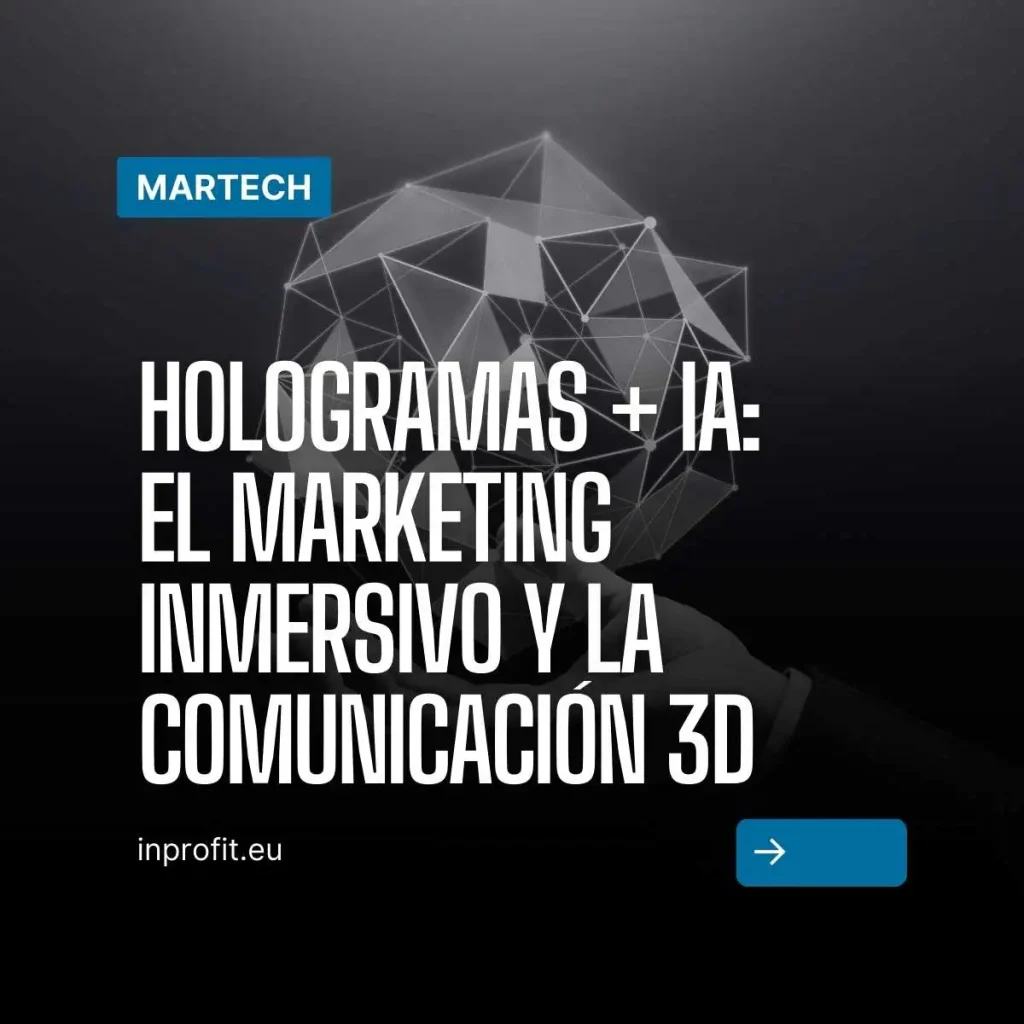The future is no longer a distant projection on a science fiction screen. It is here, literally floating in front of us, in the form of holograms powered by artificial intelligence. Imagine attending a meeting with a colleague who, although physically in Tokyo, appears sitting in front of you in your Madrid office, in volumetric 3D, interacting in real time as if you were present. Or walking through a shopping mall where the ads are not static billboards, but virtual assistants that recognize your face, anticipate your needs and converse with you.
AI + Advertising = Holograms
This is not a fantasy. Companies such as Microsoft (Mesh), Looking Glass Factory and Light Field Lab are already deploying holographic technologies that, combined with Generative AI, machine learning and natural language processing (NLP)are redefining communication, retail and entertainment. But how do these systems really work, what makes them different from simple visual effects? And, most importantly, how can brands leverage them before they become commoditized?
In this article, we’ll explore not only the technology behind AI holograms, but also their practical applications in immersive marketing, corporate telepresence and hyper-personalized user experiences. From technical challenges to innovative use cases, here’s everything you need to know to stay ahead of the curve.
Beyond Sci-Fi How do AI holograms work?
Modern holograms are not the static illusions of Princess Leia in Star Wars. Today, they fall into two main categories:
Volumetric projection holograms
Technologies such as Light Field Lab’ s use light fields to create three-dimensional images that float in the air, without the need for special displays or glasses. These systems rely on convolutional neural networks (CNNs) to render objects in real time, adjusting perspective according to the viewer’s angle.
Pepper’s Ghost 2.0 Holograms
An evolution of the century-old technique that now incorporates generative AI. Companies like Proto combine mirrors, smart glass and deep learning algorithms to produce holographic avatars that not only talk, but learn from every interaction.
Disruptive example: At CES 2024, BMW unveiled a holographic assistant for its cars that, using multimodal GPT-4, can signal engine components during a repair or recommend routes based on driver facial expressions.
Real applications that are changing industries
Immersive marketing and phantom retail
Physical stores are using holograms + AI to create virtual sales clerks with contextual memory. At Gucci’s flagship store in Tokyo, customers can consult a holographic fashion assistant who:
- Recognizes garments already owned (via CV)
- Suggests outfits based on weather and agenda (NLP)
- Shows how the clothes would look on them (AR + generative AI)
Result: 40% more time in store and 28% more average ticket versus traditional stores.
3D corporate telepresence
Platforms such as Microsoft Mesh allow distributed teams to collaborate around an interactive 3D model, manipulating it with natural gestures. Architects in 5 countries can simultaneously edit a hologram of a skyscraper, with changes reflected in real time thanks to GAN (Generative Adversarial Networks).
Entertainment and digital resurrection
Startups like Deep Voodoo (founded by the creators of South Park) use voice synthesis AI and holographic deepfakes to revive deceased artists at concerts. The ABBA Voyage show, where holographic versions of the band sing with realistic movements, generated $1M per night in London.
Technical challenges
Although promising, the technology faces critical hurdles:
Interaction Latency: For an AI-enabled hologram to feel “real,” it must respond in less than 300ms. Solutions like Intel’ s neuromorphic chips are addressing this.
The “Uncanny Valley” Problem: Avatars that are too human generate rejection. NVIDIA studies show that maintaining 15% stylized features improves acceptance.
Regulation of Holographic Deepfakes: The EU is already debating laws to label synthetic content, following cases such as an insurer using a hologram of a CEO without his consent.
How to get started with advertising 4.0?
It represents the fourth wave of advertising, driven by disruptive technologies such as AI, big data and automation. It goes beyond digital: it is intelligent, predictive and immersive.
Key pillars:
Hyper-personalization: Unique messages based on real-time data.
Advanced automation: Campaigns that optimize themselves through AI.
Immersive experiences: Use of AR/VR, metaverse or interactive in networks.
Interconnection with IoT: Advertising on smart devices (e.g., speakers, wearables).
Are we ready for a mixed reality?
While mixed advertising unites worlds (physical/digital), 4.0 goes deeper into the technological sophistication of this mix. For example:
- A (mixed) billboard could use facial recognition (4.0) to change its message according to the profile of the passerby.
- An ad on TV (mixed) could lead to an augmented reality experience on mobile (4.0).
The future is not to choose between one or the other, but to combine them to create more robust and relevant strategies.
AI holograms are not just a publicity stunt. They are the next evolution in how we work, shop and connect. By 2027, Gartner predicts that 40% of large enterprises will have some form of holographic telepresence.
The question is: At what point will you cross the line between physical and holographic in your business? Will it be in customer service, training or perhaps brand storytelling?




